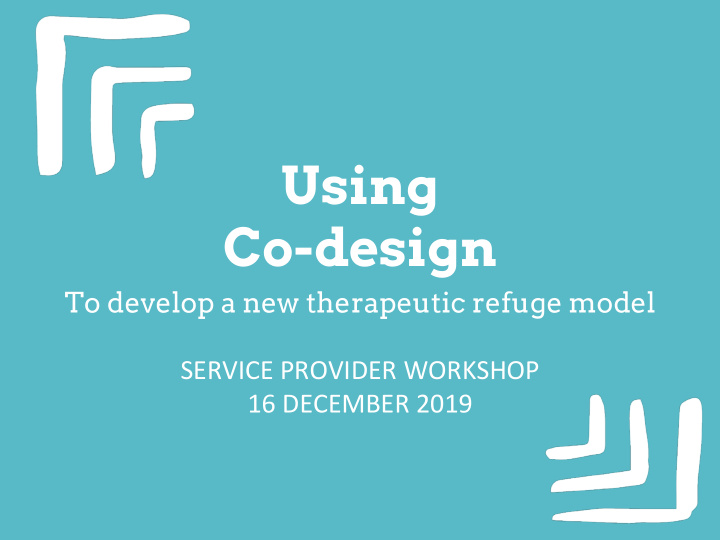



Using Co-design To develop a new therapeutic refuge model SERVICE PROVIDER WORKSHOP 16 DECEMBER 2019
Welcome to Country Uncle Harry Nannup
Welcome
Session Overview 10.00am Opening & Project Background 10.20am Understanding the Service System 11.00am Priority Opportunities for Change 11.20am BREAK 11.30am High Impact Innovations for the New Service Model 12.20pm Workshop finish Facilitators - Innovation Unit: Keren Caple ● Sash Milne ● Alison Gibson ● Claire Dodd ●
Introduce yourself to the people either side of you: ● Your name ● Answer to the question “what brings you to the room today?”
About the Project As part of the WA Labor Stopping Family and Domestic ● Violence (FDV) Policy, the government has committed to establishing a Therapeutic Refuge. The Therapeutic Refuge Project is an evidence informed ● service model expected to support a wide range of immediate health and community outcomes , including supporting women and children to live free from violence, facilitating appropriate care for complex and co- occurring health issues , and where applicable, supporting women to be reunified with their children in care. The service is expected to lead to longer term outcomes ● around independence, increased self-esteem, confidence, mental health and wellbeing and reduced levels of substance misuse.
Strategic Context ● WA Labor Stopping Family and Domestic Violence (FDV) Policy ● National Plan to Reduce Violence Against Women and Children 2010-2022 ● Western Australia’s Strategy to Reduce Family and Domestic Violence 2020-2030 (pending) ● Our Priorities ● All Paths Lead to a Home: Western Australia’s 10 -Year Strategy on Homelessness 2020 – 2030
Why co-design? Co-design is a human centred and collaborative approach to problem solving that implements disciplined innovation to tackle complex problems. The co-design process brings together diverse voices and experiences to better understand complex systems and to design potential solutions, together. Co-design implements tools and ways of working that acknowledge and recognise that it is important that everyone is able to participate fully and meaningfully. This approach not only has high potential for impact but also generates buy-in from those who participate whether they are end service users, government stakeholders and/or sector professionals.
The approach The approach to the stakeholder engagement and co-design for the Therapeutic Refuge in Peel has been designed with a commitment to: Support equity and diversity; ● Honour and respect the lived experience of victims of family ● and domestic violence; A process design that is iterative and responsive, mobilising ● energy for stakeholder and community buy-in; and Developing a compelling and engaging vision for a ● therapeutic refuge model to be trialled in the Peel region. The voice of lived experience will be privileged throughout the process.
Timeline Developing new ideas Evaluation Generating insights december january february march Mobilising energy Service user engagement Service provider and Peak Body engagement Government, Peak Bodies and local reference group stakeholder engagement
Mindsets for Social Innovation Curiosity | Being radically open and unburdened by expertise People are the experts | Privileging the views and participation of people with lived experience Learning by doing | Preferring to learn through action to improve our ideas Comfort with failure | Cherishing the learning opportunities failure brings Being in the grey | Being comfortable with ambiguity and not knowing the answers
Understanding the System ● At tables and in groups of 3, explore 1 journey map ● Record any barriers and enablers that you can think of on the sheet/s provided, prompted by the journey
Priority Opportunities for Change ● As a group, decide on 3-5 common or high priority barriers to take through to the next activity
BREAK
High Impact Innovations ● Work in pairs on one barrier at a time ● Brainstorm ideas for how to turn barriers into opportunities and innovations ● When you hear the signal, pass your sheet onto another pair ● You will work on 3 x barriers at 10 mins each
Rules of a Brainstorm Anything is possible | The best ideas are often ● somewhere between being too wild and too safe, but it’s easier to ‘roll’ an idea down the hill than up it! Defer judgement | This is a safe space where all ideas are ● good ideas; we don’t judge or criticise (instead of ‘no, but’ try ‘yes, and’) Quantity over quality | We don’t need to explain, analyse, ● interrogate or discuss ideas at this point. Everyone has a voice | Everyone’s thoughts are ● important, so we make sure everyone is heard, and don’t talk over one another. Keep it legible | Please use markers (rather than pens) ● and write clearly - we need to be able to read these later!
Final Reflection ● From your perspective, what is the one greatest opportunity for the therapeutic refuge service model? ● Take time to think ● Record on a large sticky note to put on the wall
ANY QUESTIONS? For further comments and questions, please contact contact FDVRefugePeel@communities.wa.gov.au
THANK YOU
Recommend
More recommend